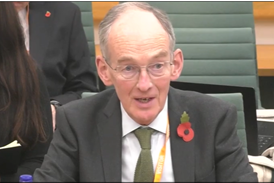Whatever its cause, a backlog of over 73,000 Crown court cases is not acceptable. Delays for complainants, defendants and witnesses all impede justice. In the third quarter of 2024, the Crown court received over 31,683 new cases and disposed of 29,502. The passage of time will not solve the problem. Change is inevitable.


Sir Brian Leveson (pictured below), who is spearheading a major review of the criminal courts, has at his disposal the relevant parts of the closely argued report of Sir Robin Auld, published in September 2001, and his own earlier review published in January 2015. In considering his report, the government must also look at other possible developments in the criminal justice system, particularly the outcome of the Independent Sentencing Review (the Gauke review). If that review recommends more community penalties and a general reduction in sentence lengths, this may impact on the number of cases ending by way of a guilty plea which, in turn, will steadily reduce the pressure on Crown court caseloads.
While the terms of Sir Brian’s review do not include ‘wider cross-system’ efficiencies, they do encompass ‘any other recommendations to tackle the outstanding caseload’. Sir Brian should consider the single greatest difficulty: the fact that both magistrates’ court and Crown court ‘receipts’ are greater than disposals. No doubt Sir Brian’s review will engage with both the immediate-term risk of the collapse of the criminal justice system as well as longer-term reforms.

Reform of the entry point to the court system would tackle the outstanding caseload. Increased use of out-of-court disposals, including potential diversionary cautions, would act as a filter for cases. This would require little by way of reform. Diversionary cautions, or a strengthened alternative, would be particularly suitable for those of good character, or who are committing crime because of addiction or mental ill-health. Local schemes would address the issues. Work on such schemes should continue and be developed. In effect, these would pull forward equivalent interventions to those offered by the Probation Service. What is more, drastic change to the right to a jury trial, and to the system of case allocation, may be unnecessary.
If further change is needed, the reclassification of ‘either-way’ offences as summary only appears to offer little as a way forward. If receipts continue to exceed disposals, then more drastic change will be required, including re-examining the procedures for ‘either-way’ offences.
The history of the right to jury trial was carefully examined by Sir Robin. There has long been a view in some quarters that, at a time of Crown court delays, some defendants who are anxious to avoid an adverse conclusion to their case will elect for Crown court trial when it is available. This is seen as a way to delay the outcome or a hope that something may ‘turn up’, as witnesses and complainants disengage.
Sir Robin looked in detail at the key issue of allocation of either-way offences. He appreciated that defendants are more likely to elect summary trial only if there are certainties as to sentence within the lower court’s powers. He recommended the abolition, after trial, of committals for sentence. In contrast, Sentencing Council guidelines on allocation currently lay great emphasis on the power to commit for sentence after a summary trial. When looking for reform and efficiency, this is a mistaken view, even if it means that the magistrates’ court should simply (for the purposes of allocation) take the prosecution case at its highest. The combination of sentencing being kept in the magistrates’ court, as well as the more permissive route of appeal, would increase the attractiveness of a summary trial. In and of itself, this could produce a material reduction in the number of defence elections. This may be a more attractive route as it encourages greater use of summary trial, rather than restricting the use of jury trial.
That said, it is clear that central to Sir Brian’s considerations will be an intermediate level of trial for a group of ‘either-way’ cases where a defence election for trial will no longer be available. The issue was examined in detail in chapter 7 of the Auld report. This need not involve a new court and could be seen as an upper division of the magistrates’ court where a professional judge (district judge, deputy district judge, recorder, or circuit judge as appropriate) sits with two lay justices. This division could have more limited sentencing powers than the Crown court, but greater than in the summary jurisdiction.
The process for appeals will not be straightforward. It is foreseeable that an increase in summary trials will lead to an increase of appeals to the Crown court and/or appeals by way of case stated. The physical location of any new court is a secondary consideration. Although magistrates’ court buildings could be suitable, many are in a state of disrepair and would need adaptation for longer trials.
The history of the right to jury trial is not as extensive as some imagine and was well analysed by Auld in chapter 5 of his report. Notwithstanding that history, a proposal to reduce the right to jury trial will cause great concern. Two Criminal Justice (Mode of Trial) Bills failed in 1999 and 2000 over difficulties in defining the relevant criteria. Any change should be as limited as possible while reducing the workload in the Crown court to manageable levels. If he goes down this route, Sir Brian will need a full analysis of the statistics in order to decide which cases might be heard in the higher division of the magistrates’ court (or a different formulation of the intermediate court).
If there is to be a form of intermediate court, it would be preferable for there to be a clear, easily understandable, allocation process. We propose that there would be a two-stage allocation process that identifies specified offences and a reasonable level of seriousness. This means that certain either-way cases, either due to their nature or due to the potential sentence, would remain in the Crown court. As to the level of seriousness, sentences of two years or less (that is, capable of being suspended) would be a reasonable ceiling.
On a guilty plea, the magistrates’ court could deal with the case or commit for sentence to the upper division or to the Crown court as appropriate.
If a not-guilty plea is indicated, the allocation hearing would be held. This would result in a two-staged allocation process:
(1) is the offence a specified either-way offence?
(a) if it is not a specified either-way offence, then the allocation process proceeds as normal.
(b) if it is a specified either-way offence, then proceed to question (2).
(2) following applicable sentencing guidelines, would result in a maximum sentence of (two) years?
The parties may choose summary trial and the court accepts jurisdiction. For a case falling outside that jurisdiction but within that of the upper division, arguments would be heard if the defence or prosecution believes that there should be a Crown court jury trial. The relevant issues are difficult to identify and have previously been considered by both Sir Robin and Sir Brian. They have also been debated in parliament as the mode of trial bills failed. The issue of disclosure will have to be considered. Despite Sir Brian’s earlier report addressing disclosure in the magistrates’ court, disclosure does not work satisfactorily and contacting a reviewing lawyer continues to be a matter of great difficulty. This particular issue will also require consideration of whether a defence statement will be required for trials conducted in the intermediate court.
There should be a paper-based right of appeal on the allocation decision to a senior circuit judge or their nominee. For cases considered to be outside the jurisdiction of the upper division, current procedures would continue, with cases being sent to the Crown court because the magistrates’ court decides that is the correct place of trial, or on the election of the defence.
Further issues will need to be considered. Magistrates’ courts are not short of work and many are under significant and sustained pressure. Funding for the magistrates’ court is less headline-grabbing than funding for the Crown court. There needs to be a mechanism to ensure that the ‘fix’ does not inadvertently obscure the systemic issues.
Research is needed to see if there are enough professional lawyers to staff the new division and enough experienced magistrates or salaried judges available to sit for extended periods to hear trials at that level. The ability of such magistrates to stand their ground with professional judges, on findings of fact, would be a key factor in giving the public confidence in the adjusted system that jury trials presently enjoy.
We end where we began. As of September 2024, there were 327,228 open cases in the magistrates’ court. While receipts increased by 3% on the previous year, disposals declined by 5%. For the past six quarters, magistrates’ court receipts have outstripped disposals. This underlines the need to extend out-of-court disposals (where there has been a 1% reduction) and to reform the entryway to the court system.
Anthony Edwards is a retired solicitor and former senior partner of TV Edwards. Matthew Hardcastle is a criminal litigation partner at Kingsley Napley LLP






























